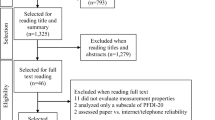Abstract
Web-based questionnaires are increasingly employed for clinical research. To investigate whether web-based and paper versions of the Pelvic Floor Distress Inventory 20 (PFDI-20) and Pelvic Floor Impact Questionnaire 7 (PFIQ-7) yield similar results, we compared results obtained with these two modes of administration. Women with pelvic floor disorders completed both versions of these questionnaires. Scores between modes of administration were compared using the paired t test and the intraclass correlation coefficient (ICC). Among the 52 participants, there were no significant differences in scores or scale scores between the web-based and paper questionnaires. The ICC was 0.91 for the PFDI-20 score and 0.81 for the PFIQ-7 score (p < 0.001 for each). The web-based format was preferred by 22 participants (53%), ten (24%) preferred the paper format, and nine (21%) had no preference. The acceptability and score equivalence recommend these web-based questionnaires as an alternative to paper questionnaires for clinical research.
Similar content being viewed by others
References
de Tayrac R, Picone O, Chauveaud-Lambling A, Fernandez H (2006) A 2-year anatomical and functional assessment of transvaginal rectocele repair using a polypropylene mesh. Int Urogynecol J Pelvic Floor Dysfunct 17(2):100–105
Barber MD, Kuchibhatla MN, Pieper CF, Bump RC (2001) Psychometric evaluation of 2 comprehensive condition-specific quality of life instruments for women with pelvic floor disorders. Am J Obstet Gynecol 185(6):1388–1395
Lukacz ES, Lawrence JM, Contreras R, Nager CW, Luber KM (2006) Parity, mode of delivery, and pelvic floor disorders. Obstet Gynecol 107(6):1253–1260
Fitzgerald MP, Janz NK, Wren PA et al (2007) Prolapse severity, symptoms and impact on quality of life among women planning sacrocolpopexy. Int J Gynaecol Obstet 98(1):24–28
Barber MD, Walters MD, Bump RC (2005) Short forms of two condition-specific quality-of-life questionnaires for women with pelvic floor disorders (PFDI-20 and PFIQ-7). Am J Obstet Gynecol 193(1):103–113
Bushnell DM, Martin ML, Parasuraman B (2003) Electronic versus paper questionnaires: a further comparison in persons with asthma. J Asthma 40(7):751–7620
Bushnell DM, Reilly MC, Galani C et al (2006) Validation of electronic data capture of the irritable bowel syndrome—Quality of Life Measure, the Work Productivity and Activity Impairment Questionnaire for Irritable Bowel Syndrome and the EuroQol. Value Health 9(2):98–105
Bischoff-Ferrari HA, Vondechend M, Bellamy N, Theiler R (2005) Validation and patient acceptance of a computer touch screen version of the WOMAC 3.1 osteoarthritis index. Ann Rheum Dis 64(1):80–84
Cook AJ, Roberts DA, Henderson MD, Van Winkle LC, Chastain DC, Hamill-Ruth RJ (2004) Electronic pain questionnaires: a randomized, crossover comparison with paper questionnaires for chronic pain assessment. Pain 110(1–2):310–317
Velikova G, Wright EP, Smith AB et al (1999) Automated collection of quality-of-life data: a comparison of paper and computer touch-screen questionnaires. J Clin Oncol 17(3):998–1007
Kleinman L, Leidy NK, Crawley J, Bonomi A, Schoenfeld P (2001) A comparative trial of paper-and-pencil versus computer administration of the Quality of Life in Reflux and Dyspepsia (QOLRAD) questionnaire. Med Care 39(2):181–189
Turner CF, Ku L, Rogers SM, Lindberg LD, Pleck JH, Sonenstein FL (1998) Adolescent sexual behavior, drug use, and violence: increased reporting with computer survey technology. Science 280(5365):867–873
Kissinger P, Rice J, Farley T et al (1999) Application of computer-assisted interviews to sexual behavior research. Am J Epidemiol 149(10):950–954
Tourangeau R, Smith T (1996) Asking sensitive questions: the impact of data collection mode, question format, and question context. Public Opin Q 60(2):275–304
Streiner DL, Norman GR (1995) Methods of administration. In: Streiner DL, Norman GR (eds) Health measurement scales: a practical guide to their development and use. 2nd edn. Oxford Medical, New York, NY, pp 189–205
Baron G, Tubach F, Ravaud P, Logeart I, Dougados M (2007) Validation of a short form of the Western Ontario and McMaster Universities Osteoarthritis Index function subscale in hip and knee osteoarthritis. Arthritis Rheum 57(4):633–638
Acknowledgments
This research was supported by grants from the National Institute of Child Health and Human Development (K23HD045806), The American Urogynecologic Society, and The Society of Gynecologic Surgeons.
Conflicts of interest
None.
Author information
Authors and Affiliations
Corresponding author
Rights and permissions
About this article
Cite this article
Handa, V.L., Barber, M.D., Young, S.B. et al. Paper versus web-based administration of the Pelvic Floor Distress Inventory 20 and Pelvic Floor Impact Questionnaire 7. Int Urogynecol J 19, 1331–1335 (2008). https://doi.org/10.1007/s00192-008-0651-6
Received:
Accepted:
Published:
Issue Date:
DOI: https://doi.org/10.1007/s00192-008-0651-6




